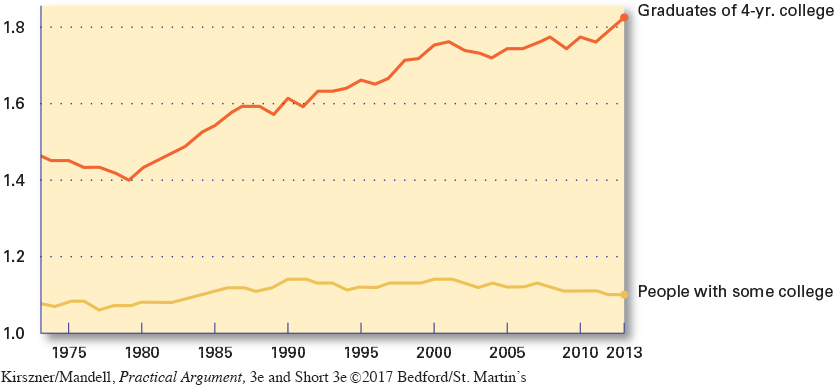Leonhardt, Is College Worth it? Clearly, New Data Say
This essay appeared in the New York Times on May 27, 2014.
IS COLLEGE WORTH IT? CLEARLY, NEW DATA SAY
DAVID LEONHARDT
Rising Value of a College Degree
1
The pay of people with a four-

2
Some newly minted college graduates struggle to find work. Others accept jobs for which they feel overqualified. Student debt, meanwhile, has topped $1 trillion.
3
It’s enough to create a wave of questions about whether a college education is still worth it.
4
A new set of income statistics answers those questions quite clearly: Yes, college is worth it, and it’s not even close. For all the struggles that many young college graduates face, a four-
5
The pay gap between college graduates and everyone else reached a record high last year, according to the new data, which is based on an analysis of Labor Department statistics by the Economic Policy Institute in Washington. Americans with four-
Page 34
6
The pay of people with a four-
7
There is nothing inevitable about this trend. If there were more college graduates than the economy needed, the pay gap would shrink. The gap’s recent growth is especially notable because it has come after a rise in the number of college graduates, partly because many people went back to school during the Great Recession. That the pay gap has nonetheless continued growing means that we’re still not producing enough of them.
8
“We have too few college graduates,” says David Autor, an M.I.T. economist, who was not involved in the Economic Policy Institute’s analysis. “We also have too few people who are prepared for college.”
9
It’s important to emphasize these shortfalls because public discussion today—
10
When experts and journalists spend so much time talking about the limitations of education, they almost certainly are discouraging some teenagers from going to college and some adults from going back to earn degrees. (Those same experts and journalists are sending their own children to college and often obsessing over which one.) The decision not to attend college for fear that it’s a bad deal is among the most economically irrational decisions anybody could make in 2014.
11
“Not going to college will cost you about half a million dollars.”
The much-
12
Mr. Autor’s paper—
13
This calculation is necessarily imprecise, because it can’t control for any pre-
14
In a similar vein, the new Economic Policy Institute numbers show that the benefits of college don’t go just to graduates of elite colleges, who typically go on to earn graduate degrees. The wage gap between people with only a bachelor’s degree and people without such a degree has also kept rising.
Page 35
15
Tellingly, though, the wage premium for people who have attended college without earning a bachelor’s degree—
16
But what about all those alarming stories you hear about indebted, jobless college graduates?
17
The anecdotes may be real, yet the conventional wisdom often exaggerates the problem. Among four-
18
I find the data from the Economic Policy Institute especially telling because the institute—
19
The average hourly wage for college graduates has risen only 1 percent over the last decade, to about $32.60. The pay gap has grown mostly because the average wage for everyone else has fallen—
20
From the country’s perspective, education can be only part of the solution to our economic problems. We also need to find other means for lifting living standards—
21
But from almost any individual’s perspective, college is a no-
22
Not so many decades ago, high school was considered the frontier of education. Some people even argued that it was a waste to encourage Americans from humble backgrounds to spend four years of life attending high school. Today, obviously, the notion that everyone should attend 13 years of school is indisputable.
23
But there is nothing magical about 13 years of education. As the economy becomes more technologically complex, the amount of education that people need will rise. At some point, 15 years or 17 years of education will make more sense as a universal goal.
24
That point, in fact, has already arrived.
Page 36
AT ISSUE: SOURCES FOR STRUCTURING AN ARGUMENT
Paraphrase this essay’s thesis statement by filling in the following template.
Because _______________________________, a four-
year college degree is now more important than ever. To support his position, Leonhardt relies largely on statistics. Where does he include other kinds of supporting evidence?
Look at the graph that follows paragraph 1, and read its caption. What does this image add to the essay? Would Leonhardt’s argument have been as convincing without the graph? Why or why not?
In paragraph 8, Leonhardt quotes economist David Autor. How do you suppose Marty Nemko would respond to Autor’s statements?
In paragraph 16, Leonhardt asks a question to introduce an argument opposed to his position. What is this argument? Does he refute it effectively in the discussion that follows?
In paragraph 22, Leonhardt begins his conclusion with an analogy. What two things is he comparing? What point is he making? Do you think this concluding strategy is effective? Why or why not? How else could he have ended his essay?